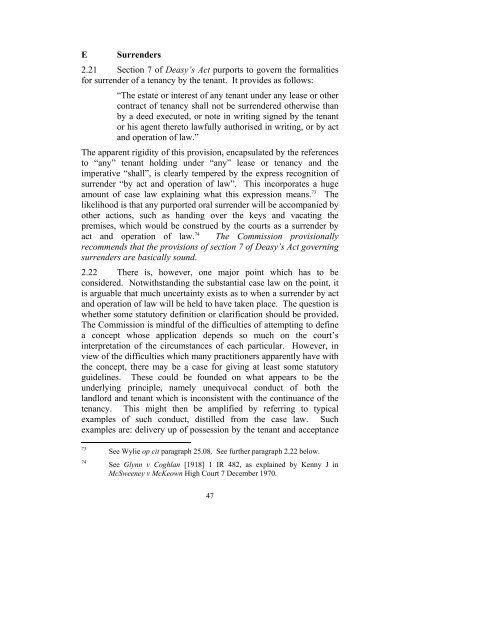Consultation Paper on the General Law of the Landlord and Tenant
Consultation Paper on the General Law of the Landlord and Tenant
Consultation Paper on the General Law of the Landlord and Tenant
You also want an ePaper? Increase the reach of your titles
YUMPU automatically turns print PDFs into web optimized ePapers that Google loves.
E Surrenders2.21 Secti<strong>on</strong> 7 <strong>of</strong> Deasy’s Act purports to govern <strong>the</strong> formalitiesfor surrender <strong>of</strong> a tenancy by <strong>the</strong> tenant. It provides as follows:“The estate or interest <strong>of</strong> any tenant under any lease or o<strong>the</strong>rc<strong>on</strong>tract <strong>of</strong> tenancy shall not be surrendered o<strong>the</strong>rwise thanby a deed executed, or note in writing signed by <strong>the</strong> tenantor his agent <strong>the</strong>reto lawfully authorised in writing, or by act<strong>and</strong> operati<strong>on</strong> <strong>of</strong> law.”The apparent rigidity <strong>of</strong> this provisi<strong>on</strong>, encapsulated by <strong>the</strong> referencesto “any” tenant holding under “any” lease or tenancy <strong>and</strong> <strong>the</strong>imperative “shall”, is clearly tempered by <strong>the</strong> express recogniti<strong>on</strong> <strong>of</strong>surrender “by act <strong>and</strong> operati<strong>on</strong> <strong>of</strong> law”. This incorporates a hugeamount <strong>of</strong> case law explaining what this expressi<strong>on</strong> means. 73 Thelikelihood is that any purported oral surrender will be accompanied byo<strong>the</strong>r acti<strong>on</strong>s, such as h<strong>and</strong>ing over <strong>the</strong> keys <strong>and</strong> vacating <strong>the</strong>premises, which would be c<strong>on</strong>strued by <strong>the</strong> courts as a surrender byact <strong>and</strong> operati<strong>on</strong> <strong>of</strong> law. 74 The Commissi<strong>on</strong> provisi<strong>on</strong>allyrecommends that <strong>the</strong> provisi<strong>on</strong>s <strong>of</strong> secti<strong>on</strong> 7 <strong>of</strong> Deasy’s Act governingsurrenders are basically sound.2.22 There is, however, <strong>on</strong>e major point which has to bec<strong>on</strong>sidered. Notwithst<strong>and</strong>ing <strong>the</strong> substantial case law <strong>on</strong> <strong>the</strong> point, itis arguable that much uncertainty exists as to when a surrender by act<strong>and</strong> operati<strong>on</strong> <strong>of</strong> law will be held to have taken place. The questi<strong>on</strong> iswhe<strong>the</strong>r some statutory definiti<strong>on</strong> or clarificati<strong>on</strong> should be provided.The Commissi<strong>on</strong> is mindful <strong>of</strong> <strong>the</strong> difficulties <strong>of</strong> attempting to definea c<strong>on</strong>cept whose applicati<strong>on</strong> depends so much <strong>on</strong> <strong>the</strong> court’sinterpretati<strong>on</strong> <strong>of</strong> <strong>the</strong> circumstances <strong>of</strong> each particular. However, inview <strong>of</strong> <strong>the</strong> difficulties which many practiti<strong>on</strong>ers apparently have with<strong>the</strong> c<strong>on</strong>cept, <strong>the</strong>re may be a case for giving at least some statutoryguidelines. These could be founded <strong>on</strong> what appears to be <strong>the</strong>underlying principle, namely unequivocal c<strong>on</strong>duct <strong>of</strong> both <strong>the</strong>l<strong>and</strong>lord <strong>and</strong> tenant which is inc<strong>on</strong>sistent with <strong>the</strong> c<strong>on</strong>tinuance <strong>of</strong> <strong>the</strong>tenancy. This might <strong>the</strong>n be amplified by referring to typicalexamples <strong>of</strong> such c<strong>on</strong>duct, distilled from <strong>the</strong> case law. Suchexamples are: delivery up <strong>of</strong> possessi<strong>on</strong> by <strong>the</strong> tenant <strong>and</strong> acceptance7374See Wylie op cit paragraph 25.08. See fur<strong>the</strong>r paragraph 2.22 below.See Glynn v Coghlan [1918] 1 IR 482, as explained by Kenny J inMcSweeney v McKeown High Court 7 December 1970.47
















